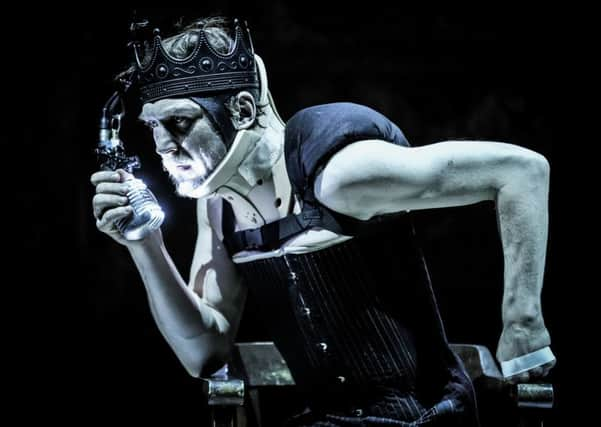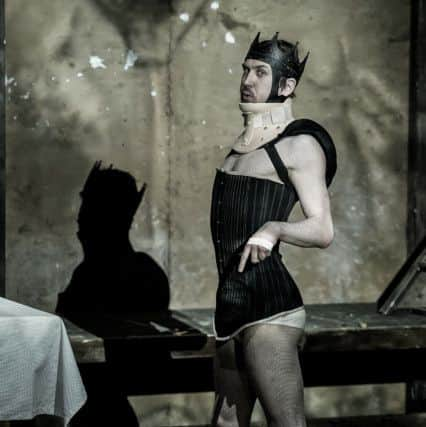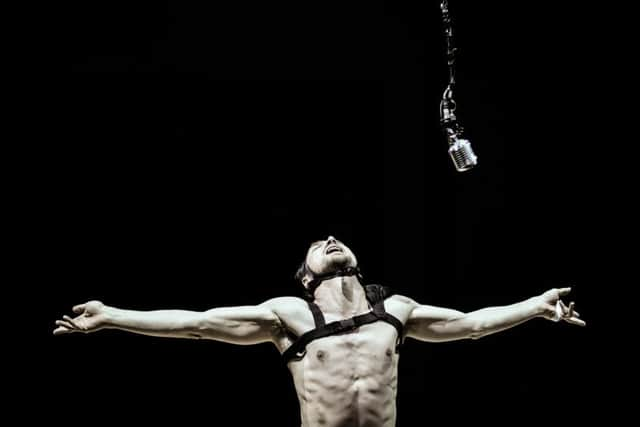Richard III performance is a study in evil


THE date is 23 April, 2016, the exact 400th anniversary of Shakespeare’s death; and at the National Theatre in Craiova, Romania, the demand for seats in the main auditorium is so fierce that many of the audience – international visitors, regular theatregoers, hundreds of students – are packed onto the steps at the side of the auditorium, or crammed into the back rows, two to a seat.
The occasion is a joint celebration of the European Theatre Prize – an EU-funded raft of awards presented every few years in a city somewhere in Europe – and of Craiova’s biennial Shakespeare festival; and the show that is causing such intense excitement is Thomas Ostermeier’s Schaubűhne production of Richard III, first seen in Berlin last year, and now visiting Craiova in advance of its appearance at this year’s Edinburgh International Festival.
Advertisement
Hide AdAdvertisement
Hide AdAnd as the production unfolds, on a stage backed by rusty, blood-coloured metal walls, this mainly young audience is not disappointed. For Ostermeier’s production is dominated by an extraordinary central performance from German cult star Lars Eidinger – actor, performer, DJ, and an unforgettable Richard, a tall, lanky figure loping around the stage with the strange twisted gait that fits his hunchback status, wearing the strange Bosch-like leather helmet once used to protect epilepsy sufferers from falls, yet absolutely charismatic and compelling, and almost immediately bound into a strange, complicit relationship with the audience.


“The idea behind the production was to make a study of evil,” says Ostermeier, after the show, the award ceremony, and his own graceful speech dedicating the performance to the memory of Shakespeare, and the 400th anniversary. “But the whole point about making a production is that you don’t stick to that first idea – in the process, something happens, it changes. You play with the theory.
“And what has emerged here is – among other things – something about the power of language, and the use of masks. In the scene where Richard refuses the crown, for instance, there is this close relationship with religion, and with the idea of religion as a mask, a way of concealing vice. The audience really like this, I notice, and identify with it.
“So Richard is hiding behind a mask of one kind or another, and this also gives him the power to be very erotic, very sexually seductive. In effect, he tells the audience, “I make a bet that I can do this. Watch me, and see if I succeed…” He goes one step further, then one step further, into what seems unthinkable. He role-plays, he bluffs, he keeps raising the stakes. And this is attractive, this makes him erotically attractive.”
Ostermeier’s growing interest in Shakespeare is a relatively new feature of a directing career that was first shaped by a series of intense encounters with the 1990s in-your-face generation of new British playwrights, including Sarah Kane and Mark Ravenhill, and with other ground-breaking new work from across Europe.


Ostermeier was appointed director of the legendary Berlin Schaubűhne in 1999, at the age of only 31, and the company continues to work with many living writers; but since his acclaimed production of Hamlet, back in 2008, he has found himself increasingly fascinated by the intense layers of audience interaction implied in Shakespeare’s work, and by what he calls its post-modern elements, blasting away the “fourth wall” of conventional theatre.
“Recently, we put a little Globe Theatre into one of our big spaces at the Schaubűhne,” Ostermeier explains, “so that we could experiment with this audience relationship that appears in Shakespeare’s work. It’s very intimate, just 300 seats, and it encourages all that audience engagement. The idea is that every actor is like a stand-up comedian, interacting with the audience – this production, for example, really works best if you can get it into this kind of half-circle.
Advertisement
Hide AdAdvertisement
Hide Ad“With Richard, the idea is to make the audience complicit in what he is doing. I want them to discern in themselves this capacity to get involved in evil, and to enjoy it. I want them to to think about this.
“I’ve become very interested recently in the mediaeval morality play tradition, and in the way the vice figure becomes the accomplice of the audience, the most popular one. Richard is physically deformed, and maybe also epileptic, yet at the same time he’s also very strong, a great fighter. He kills them all, you know, and in the battle he’s always in front. So there is always this mix of heroism and evil, repulsion and attraction.


“For the future – well, I always have plays in mind that I want to do, and it’s a matter of finding the moment when you can see the right cast, and the time feels right. I do have a list of Shakespeare plays – Macbeth is on it, and the whole Richard II-Henry IV cycle. And Twelfth Night – I really want to do that.
“It’s true that in my work as a director, I was first drawn to the very young and angry British playwriting of the 1990s. But now in all my work, including Shakespeare, I think I’m increasingly interested in exploring the post-modern and the post-dramatic, and creating a mash-up of different genres. This is why we’ve created this Globe, so that we can explore these elements, which are so present in Shakespeare. So yes, it’s the 21st century; and we’re exploring what’s post-dramatic, in drama.”
Richard III, Royal Lyceum Theatre, 24-28 August